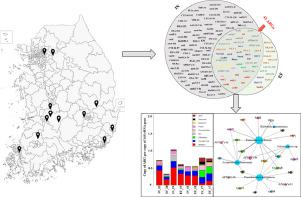Water Research ( IF 12.8 ) Pub Date : 2021-11-19 , DOI: 10.1016/j.watres.2021.117882 Shahbaz Raza 1 , Hanseob Shin 2 , Hor-Gil Hur 2 , Tatsuya Unno 3

|
Wastewater treatment plants (WWTPs) receive sewage water from a variety of sources, including livestock farms, hospitals, industries, and households, that contain antimicrobial resistant bacteria (ARB) and antimicrobial resistant genes (ARGs). Current treatment technologies are unable to completely remove ARB and ARGs, which are eventually released into the aquatic environment. This study focused on the core resistome of urban WWTPs that are persistent through wastewater treatment processes. We adopted the Hiseq-based metagenomic sequencing approach to identify the core resistome, their genetic context, and pathogenic potential of core ARGs in the influent (IN) and effluent (EF) samples of 12 urban WWTPs in South Korea. In this study, the abundance of ARGs ranged from 0.32 to 3.5 copies of ARGs per copy of the 16S rRNA gene, where the IN samples were relatively higher than the EF samples, especially for the macrolide-lincosamide-streptogramin (MLS)- and tetracycline- resistant genes. On the other hand, there were 43 core ARGs sharing up to 90% of the total, among which the relative abundance of sul1, APH(3ʹʹ)-lb, and RbpA was higher in EF than in IN (p<0.05). Moreover, tetracycline and sulfonamide-related core ARGs in both EF and IN were significantly more abundant on plasmids than on chromosomes (p<0.05). We also found that the majority of core ARGs were carried by opportunistic pathogens such as Acinetobacter baumannii, Enterobacter cloacae, and Pseudomonas aeruginosa in both IN and EF. In addition, phages were the only mobile elements whose abundance correlated with that of core ARGs in EF, suggesting that transduction may play a major role in disseminating ARGs in the receiving water environment of the urban WWTP. The persistent release of core ARGs with pathogenic potential into environmental water is of immediate concern. The mobility of ARGs and ARBs in the environment is a major public health concern. These results should be taken into consideration when developing policy to mitigate environmental dissemination of ARG by WWTPs.
中文翻译:

污水处理厂出水中核心抗微生物基因的丰度更高
污水处理厂 (WWTP) 接收来自各种来源的污水,包括畜牧场、医院、工业和家庭,这些污水含有抗微生物细菌 (ARB) 和抗微生物基因 (ARG)。当前的处理技术无法完全去除最终释放到水生环境中的 ARB 和 ARG。本研究侧重于城市污水处理厂通过废水处理过程持续存在的核心抵抗力。我们采用基于 Hiseq 的宏基因组测序方法来确定韩国 12 个城市污水处理厂的进水 (IN) 和出水 (EF) 样本中核心 ARG 的核心抗性组、它们的遗传背景和致病潜力。在这项研究中,每个 16S rRNA 基因拷贝的 ARGs 丰度范围为 0.32 到 3.5 个 ARGs 拷贝,其中 IN 样本相对高于 EF 样本,尤其是大环内酯-林可酰胺-链球菌素 (MLS) 和四环素抗性基因。另一方面,有 43 个核心 ARGs 共享高达总数的 90%,其中相对丰度sul1、APH(3ʹʹ)-lb和RbpA在EF中高于在IN中(p<0.05)。此外,EF 和 IN 中四环素和磺胺相关的核心 ARG 在质粒上的含量明显高于染色体上的含量(p<0.05)。我们还发现大多数核心 ARG 由机会性病原体携带,如鲍曼不动杆菌、阴沟肠杆菌和铜绿假单胞菌在 IN 和 EF 中。此外,噬菌体是唯一与 EF 中核心 ARGs 丰度相关的移动元素,表明转导可能在城市污水处理厂接收水环境中传播 ARGs 中起主要作用。具有致病潜力的核心 ARG 持续释放到环境水中是当务之急。ARGs 和 ARBs 在环境中的流动性是一个主要的公共卫生问题。在制定政策以减轻污水处理厂对 ARG 的环境传播时,应考虑这些结果。



























 京公网安备 11010802027423号
京公网安备 11010802027423号